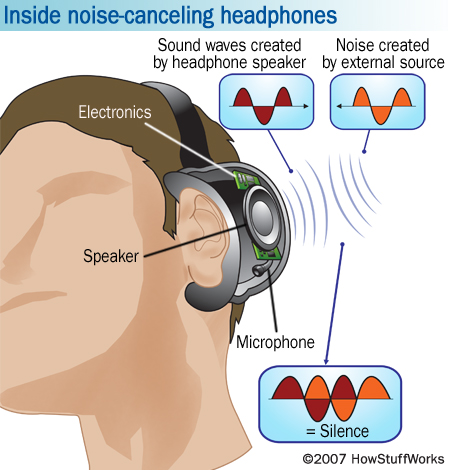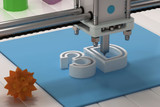How Noise-canceling Headphones Work

Unfortunately for music lovers, many types of ambient sounds can interfere with or even block the sounds coming through their headphones. If you have ever tried to listen to a CD or MP3 player on a plane, then you know the problem well: The roar of the engines makes it difficult to hear what's being piped through the speakers -- even when those speakers are situated in or on your ear. Fortunately, noise-canceling headphones can provide a more enjoyable listening experience.
Noise-canceling headphones come in either active or passive types. Technically speaking, any type of headphone can provide some passive noise reduction. That's because the materials of the headphones themselves block out some sound waves, especially those at higher frequencies. The best passive noise-canceling headphones, however, are circum-aural types that are specially constructed to maximize noise-filtering properties. That means they are packed with layers of high-density foam or other sound-absorbing material, which makes them heavier than normal headphones. The tradeoff of all that extra weight is a reduction in noise of about 15 to 20 decibels (dB). But considering jet engines create 75 to 80 dB of noise inside the aircraft cabin, passive models have some serious limitations. That's where active noise-canceling headphones come in.
Active noise-canceling headphones can do everything that passive ones can do -- their very structure creates a barrier that blocks high-frequency sound waves. They also add an extra level of noise reduction by actively erasing lower-frequency sound waves. How do noise-canceling headphones accomplish this? They actually create their own sound waves that mimic the incoming noise in every respect except one: the headphone's sound waves are 180 degrees out of phase with the intruding waves.
If you look at the illustration below, you can see how this works. Notice that the two waves -- the one coming from the noise-canceling headphone and the one associated with the ambient noise -- have the same amplitude and frequency, but their crests and troughs (compressions and rarefactions) are arranged so that the crests (compressions) of one wave line up with the troughs (rarefactions) of the other wave and vice versa. In essence, the two waves cancel each other out, a phenomenon known as destructive interference. The result: the listener can focus on the sounds he wants to hear.
Of course, several components are required to achieve this effect:
- Microphone - A microphone placed inside the ear cup "listens" to external sounds that cannot be blocked passively.
- Noise-canceling circuitry - Electronics, also placed in the ear cup, sense the input from the microphone and generate a "fingerprint" of the noise, noting the frequency and amplitude of the incoming wave. Then they create a new wave that is 180 degrees out of phase with the waves associated with the noise.
- Speaker - The "anti-sound" created by the noise-canceling circuitry is fed into the headphones' speakers along with the normal audio; the anti-sound erases the noise by destructive interference, but does not affect the desired sound waves in the normal audio.
- Battery - The term "active" refers to the fact that energy must be added to the system to produce the noise-canceling effect. The source of that energy is a rechargeable battery.
Click here to find out great deals on noise cancelling wireless headphones.
Recent Posts
-
Best Computer Screens for Home and Office
Computer display screens, often referred to simply as monitors, have undergone a remarkable evolutio …27th Dec 2023 -
Unleashing Creativity Down Under: The Best 3D Printing Filament Options in Australia
Australia has become a hub for creativity and innovation, and 3D printing is no exception. With an …3rd Jun 2023 -
How is 3D Printing Technology enhancing the Advertising Industry?
3D printing, or additive manufacturing, is the process of using digital files to create three- dime …8th May 2023

 FREE SHIPPING ON ORDER OVER $75
FREE SHIPPING ON ORDER OVER $75
 LOYALTY PROGRAM
LOYALTY PROGRAM
 SHIPPING WORLDWIDE
SHIPPING WORLDWIDE



 72 HOURS DELIVERY PROGRAM
72 HOURS DELIVERY PROGRAM